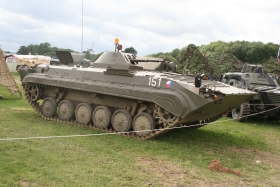What is an IFV
Although at first appearance one could be forgiven for thinking this class of vehicle was nothing more than another APC (Armoured Personnel Carrier) a closer examination will reveal the fundamental differences. These are covered in detail in the "External Details " page of this section of my web site. For this page a brief explanation will suffice. The primary difference between an IFV (Infantry Fighting Vehicle) is that the troops carried within the vehicle are able to fight from within the vehicle without the need to dismount first. Whereas with an APC the troop need to exit the vehicle in order to be able to engage the enemy thus rendering them vulnerable to all the hazards of a battlefield. Literally no more than battlefield taxis with early ones having no roof so leaving the troops insode exposed to shrapnel from overhead shell bursts. Once in position on thebattlefield a further problem is that if the vehicle is engaged by small arms fire - or worse - then the troops are unable to dismount and are therefore ineffective.
The IFV marked a revolution in AFV (Armoured Fighting Vehicle) design when it appeared in the middle of the 1960's. The West at the time had nothing like it and it's appearance sent shock-waves through the Defense Chiefs at the time. The BMP series were amphibious thus negating the need for fixed river crossings and had full NBC protection for the occupants as well as full armour protection all round. The only weak spot on the vehicle - at that time - were the rear doors which, as an aid to bouyancy were hollow and used to store additional fuel - approx 180 litres in each door, this in addition to the 480 litres in the main internal fuel tank. This conferred an operational range of over 600 Km which coupled with speeds of 40 mph (road, 30 mph (off-road and 5 mph (water) led to a very versatile machine. The ground pressure exerted by the tracks is approx 0.6 Kg/Cm2 - about the same as the average human male meant it could get to places other tracked or wheeled vehicle could not. This low ground pressure manifests itself off-road when turning as the vehicle will skid/powerslide on loose surfaces such as mud or dust.

